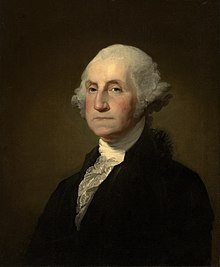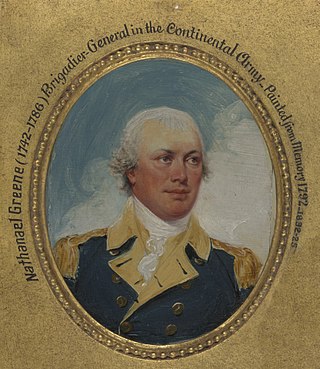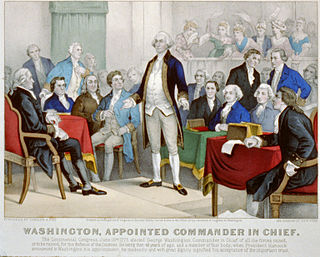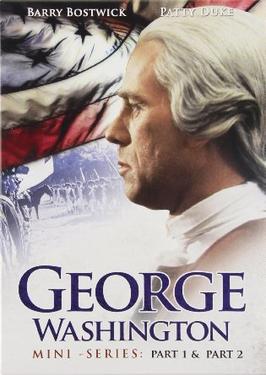
The following is a list of articles about and largely involving George Washington.

The following is a list of articles about and largely involving George Washington.

| The Washington cabinet | ||
|---|---|---|
| Office | Name | Term |
| President | George Washington | 1789–1797 |
| Vice President | John Adams | 1789–1797 |
| Secretary of State | John Jay | 1789–1790 |
| Thomas Jefferson | 1790–1793 | |
| Edmund Randolph | 1794–1795 | |
| Timothy Pickering | 1795–1797 | |
| Secretary of the Treasury | Alexander Hamilton | 1789–1795 |
| Oliver Wolcott Jr. | 1795–1797 | |
| Secretary of War | Henry Knox | 1789–1794 |
| Timothy Pickering | 1794–1796 | |
| James McHenry | 1796–1797 | |
| Attorney General | Edmund Randolph | 1789–1794 |
| William Bradford | 1794–1795 | |
| Charles Lee | 1795–1797 | |

The American Revolutionary War, also known as the Revolutionary War or American War of Independence, was the military conflict of the American Revolution. American Patriot forces, organized as the Continental Army and commanded by George Washington, defeated the British, leading to the Treaty of Paris in 1783, in which Great Britain recognized the independence and sovereignty of the United States. In the war, American Patriot forces eventually gained the support of France and Spain. The British and Loyalist forces also included Hessian soldiers from Germany. The conflict was fought in North America, the Caribbean, and the Atlantic Ocean.

George Washington was an American Founding Father, military officer, politician and statesman who served as the first president of the United States from 1789 to 1797. Appointed by the Second Continental Congress as commander of the Continental Army in 1775, Washington led Patriot forces to victory in the American Revolutionary War and then served as president of the Constitutional Convention in 1787, which drafted and ratified the Constitution of the United States and established the U.S. federal government. Washington has thus been known as the "Father of the Nation".

Thomas Mifflin was an American merchant, soldier, and politician from Pennsylvania, who is regarded as a Founding Father of the United States for his roles during and after the American Revolution. Mifflin signed the United States Constitution, was the first governor of Pennsylvania, serving from 1790 to 1799, and was also the state's last president, succeeding Benjamin Franklin in 1788.

The Continental Army was the army of the United Colonies representing the Thirteen Colonies and later the United States during the American Revolutionary War. It was formed on June 14, 1775 by a resolution passed by the Second Continental Congress, meeting in Philadelphia after the war's outbreak. The Continental Army was created to coordinate military efforts of the colonies in the war against the British, who sought to maintain control over the American colonies. General George Washington was appointed commander-in-chief of the Continental Army and maintained this position throughout the war.

Timeline of the American Revolution—timeline of the political upheaval culminating in the 18th century in which Thirteen Colonies in North America joined together for independence from the British Empire, and after victory in the Revolutionary War combined to form the United States of America. The American Revolution includes political, social, and military aspects. The revolutionary era is generally considered to have begun with the passage of the Stamp Act in 1765 and ended with the ratification of the United States Bill of Rights in 1791. The military phase of the revolution, the American Revolutionary War, lasted from 1775 to 1783.

Major-General Nathanael Greene was an American military officer and planter who served in the Continental Army during the Revolutionary War. He emerged from the war with a reputation as one of George Washington's most talented and dependable officers, and is known for his successful command in the Southern theater of the conflict.

New Jersey played a central role in the American Revolution both politically and militarily. It was the site of more than 90 military engagements, including the pivotal battles of Trenton, Princeton, and Monmouth. George Washington led his army across the state four times and encamped there during three hard winters, enduring some of the greatest's setbacks of the war as well as seminal victories. New Jersey's decisive role in the conflict earned it the title, "Crossroads of the American Revolution".

The 1st Rhode Island Regiment was a regiment in the Continental Army raised in Rhode Island during the American Revolutionary War (1775–83). It was one of the few units in the Continental Army to serve through the entire war, from the siege of Boston to the disbanding of the Continental Army on November 3, 1783.

The 1st Virginia Regiment was an infantry regiment of the Virginia Line that served with the Continental Army during the American Revolutionary War.

Pennsylvania was the site of many key events associated with the American Revolution and American Revolutionary War. The city of Philadelphia, then capital of the Thirteen Colonies and the largest city in the colonies, was a gathering place for the Founding Fathers who discussed, debated, developed, and ultimately implemented many of the acts, including signing the Declaration of Independence, that inspired and launched the revolution and the quest for independence from the British Empire.

The southern theater of the American Revolutionary War was the central theater of military operations in the second half of the American Revolutionary War, 1778–1781. It encompassed engagements primarily in Virginia, Georgia, North Carolina, and South Carolina. Tactics consisted of both strategic battles and guerrilla warfare.

Alexander Scammell was a Harvard educated attorney and an officer in the Continental Army during the American Revolutionary War. He was wounded on September 30, 1781, near Yorktown and subsequently died on October 6 in Williamsburg, Virginia, making him, a colonel, the highest ranking American officer killed during the Siege of Yorktown.

George Washington commanded the Continental Army in the American Revolutionary War (1775–1783). After serving as President of the United States, he briefly was in charge of a new army in 1798.

The military career of George Washington spanned over forty-five years of service (1752–1799). Washington's service can be broken into three periods, French and Indian War, American Revolutionary War, and the Quasi-War with France, with service in three different armed forces.

Fort Billingsport, referred to as Fort Billings in some sources, was a Continental Army fort in Billingsport in Paulsboro, New Jersey in Gloucester County, New Jersey, during the American Revolutionary War. The site of the fort is now a public park of the same name, located at the Plains Terminal at the Port of Paulsboro between two oil refineries.
Events from the year 1777 in the United States.

George Washington is a 1984 American biographical television miniseries directed by Buzz Kulik. The series, in three parts, chronicles the life of George Washington, the first President of the United States from the age of 11 to the age of 51. George Washington is based on the biography by James Thomas Flexner.

The history of Virginia in the American Revolution begins with the role the Colony of Virginia played in early dissent against the British government and culminates with the defeat of General Cornwallis by the allied forces at the Siege of Yorktown in 1781, an event signaled the effective military end to the conflict. Numerous Virginians played key roles in the Revolution, including George Washington, Patrick Henry, and Thomas Jefferson.
John Hamilton was a military officer in the British Army, and the commander of the Royal North Carolina Regiment of Loyalist provincial volunteers during the American Revolutionary War from 1777 to 1783. Prior to the Revolution, Hamilton was a successful merchant in Halifax, North Carolina, with business interests throughout the Province of North Carolina. Hamilton commanded soldiers in several major engagements, including the battles of Briar Creek, Camden, Guilford Courthouse, and Yorktown. After the conclusion of the war, Hamilton was made British consul to Norfolk, Virginia, one of only three Loyalists to receive consular positions in the newly created United States.